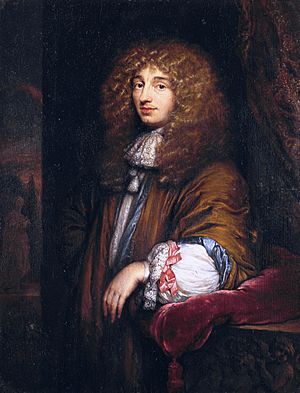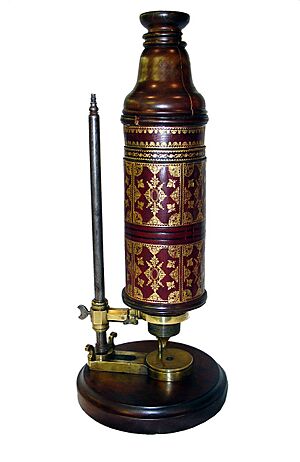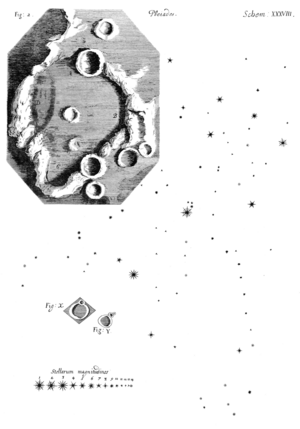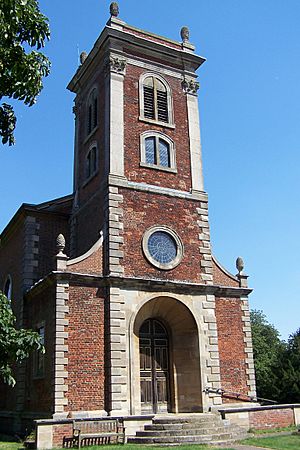Robert Hooke facts for kids
Quick facts for kids
Robert Hooke
|
|
|---|---|
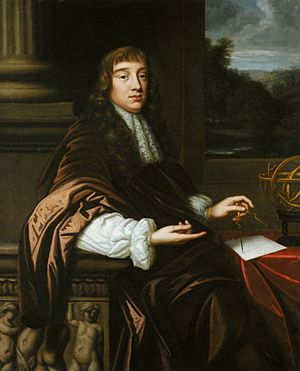
c. 1680 Portrait of a Mathematician by Mary Beale, thought to be Hooke.
|
|
| Born | 18 July 1635 Freshwater, Isle of Wight, England
|
| Died | 3 March 1703 (aged 67) London, England
|
| Resting place | St Helen's Church, Bishopsgate |
| Nationality | English |
| Alma mater | Wadham College, Oxford |
| Known for | Hooke's law Microscopy Coining the term 'cell' |
| Scientific career | |
| Fields | Physics and Biology |
| Institutions | University of Oxford |
| Academic advisors | Robert Boyle |
| Influences | Richard Busby |
| Signature | |
 |
|
Robert Hooke (1635–1703) was a brilliant English scientist, natural philosopher, and architect. He was one of the first scientists to see tiny living things, called microorganisms, in 1665. He used a special compound microscope that he built himself. Another scientist, Antonie van Leeuwenhoek, also discovered microorganisms later in 1676.
Hooke wasn't rich when he was young, but he became famous and wealthy by helping to rebuild London after the Great Fire of 1666. He was also a key member of the Royal Society, a famous science group, where he was in charge of experiments. He also taught geometry at Gresham College.
He helped scientist Robert Boyle build vacuum pumps for experiments on gases and did his own experiments too. In 1673, Hooke built one of the first Gregorian telescopes and used it to watch Mars and Jupiter spin. His 1665 book, Micrographia, was very important. In it, he first used the word "cell" to describe what he saw under his microscope, which made many others want to explore the tiny world. He studied light and thought it moved in waves. He also had early ideas that heat makes things expand, that air is made of tiny particles far apart, and that heat is a form of energy.
In physics, he figured out that gravity gets weaker the further away things are, following an 'inverse square law'. He was the first to suggest this idea for how planets move around the sun. Later, Isaac Newton developed this idea further into his famous law of universal gravitation. This led to a big disagreement between Hooke and Newton. Hooke also made important discoveries in geology and paleontology. He believed the Earth changed over time and that some animals had become extinct. He even saw tiny fossils under his microscope, which hinted at the idea of biological evolution. Hooke also helped create the first modern maps and city plans for London. Because of his many talents, he has been called "England's Leonardo".
Contents
Early Life & Education
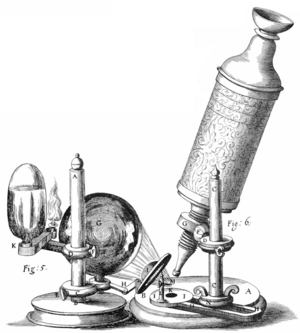
Much of what we know about Robert Hooke's early life comes from a book he started writing himself. He was born in 1635 in Freshwater, Isle of Wight, England. His father, John Hooke, was an Anglican priest and also ran a local school.
Robert was the youngest of four children. He was often sick as a child, so his father taught him at home. Young Robert loved to observe things, build mechanical devices, and draw. He once took apart a brass clock and built a working wooden copy! He even made his own drawing tools from natural materials like coal and chalk.
When his father died in 1648, Robert inherited 40 pounds. He was only 13 years old. He used this money to go to London. He first tried to become an apprentice to an artist but was convinced to go to Westminster School instead. There, he quickly learned Latin and Greek, mastered Euclid's Elements (a famous math book), and started his lifelong study of mechanics (how things move).
Studying at Oxford
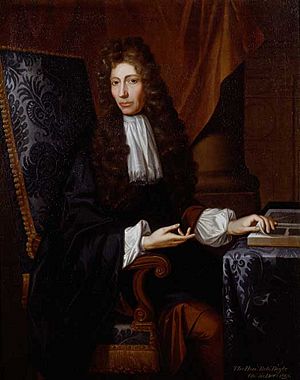
In 1653, Robert Hooke went to Christ Church at Oxford University. He worked as a "chemical assistant" for Dr. Thomas Willis, a scientist he greatly admired. At Oxford, he met another famous scientist, Robert Boyle. Hooke became Boyle's assistant from about 1655 to 1662. He built and operated Boyle's "air pump," which was used for experiments with vacuums.
Hooke felt that his time at Oxford was the start of his deep love for science. He made important friends there, like Christopher Wren, who would become a famous architect. This group of scientists and thinkers at Oxford eventually formed the core of the Royal Society. Hooke was known for his sharp eyesight and his skill in mathematics. He was a very valuable assistant to Boyle.
Working at the Royal Society
The Royal Society was founded in 1660. In 1661, Hooke was chosen to be the "Curator of Experiments" for the society. This meant it was his job to show new experiments to the members at their weekly meetings. He held this important position for over 40 years.
In 1664, he also became the Professor of Geometry at Gresham College in London. Hooke's role at the Royal Society allowed him to be at the center of scientific discoveries in Britain and beyond. He demonstrated many different experiments. For example, he showed how air works, how glass bubbles implode when heated, and that a dog could be kept alive by pumping air into its lungs. He also noticed the difference between venous and arterial blood.
He designed tools to measure tiny movements of the sun or stars. He also created an "engine" to cut very fine teeth for watches, much better than could be done by hand. This invention was still being used constantly when Hooke died.
Between 1663 and 1664, Hooke made many observations using his microscope. These observations were later put together in his famous book, Micrographia, published in 1665.
Personality & Rivalries
Hooke was known to be a loyal friend and ally. He had strong friendships with people like Christopher Wren and John Aubrey. He often met friends at coffeehouses and taverns and had dinners with Robert Boyle.
However, Hooke was also proud and sometimes got annoyed by other scientists. He believed that Henry Oldenburg, another member of the Royal Society, had shared details of his watch invention without permission. Hooke often kept his ideas secret, sometimes using secret codes.
As the Royal Society's experiment curator, Hooke had to show many ideas that others sent in. Some people think he sometimes took credit for these ideas. But during this time of rapid scientific progress, many ideas were being developed by different people at the same time. Hooke was very busy and often left his own ideas unfinished, though he did get patents for some of them.
One of his most famous rivalries was with Isaac Newton. They disagreed over who deserved credit for discoveries in physics, gravity, astronomy, and optics. After Hooke's death, Newton, who became president of the Royal Society, was accused of trying to damage Hooke's reputation. It's even said that Newton might have destroyed the only known portrait of Hooke. However, in recent times, researchers have helped bring Hooke's important contributions back into the spotlight.
Despite these disputes, Hooke was incredibly inventive, great at experiments, and a very hard worker. He received many patents for his inventions and improvements in areas like elasticity, optics, and measuring air pressure.
Scientific Discoveries
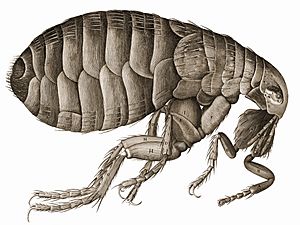
Mechanics & Elasticity
In 1660, Hooke discovered a very important rule in physics called Hooke's law. This law describes how much an elastic object, like a spring, stretches when you pull on it. It says that the stretch is directly related to the force you apply. He first wrote this discovery as a secret code, or anagram, and later revealed it in 1678 as "Ut tensio, sic vis," which means "As the extension, so the force."
Hooke's work on elasticity was very practical. It led to his invention of the balance spring (or hairspring) for watches. This invention made it possible for portable timepieces to keep time much more accurately than ever before. There was a long-standing argument between Hooke and Christiaan Huygens about who invented this first. However, a note from 1670 suggests Hooke demonstrated his balance-controlled watch to the Royal Society before Huygens published his work.
In 1680, Hooke observed patterns that formed when he vibrated glass plates covered with flour. He also showed the Royal Society in 1681 that musical sounds could be made by spinning brass gears with teeth cut in specific ways.
Gravity & Planetary Motion
Many scientists in Hooke's time believed in an invisible "aether" that carried forces between objects in space. But Hooke had a different idea. In his book Micrographia (1665), he suggested that there was a force of gravitation that pulled objects together.
In 1666, Hooke gave a lecture where he added two more important ideas about gravity:
- All objects move in straight lines unless a force changes their path.
- The pulling force of gravity is stronger when objects are closer together.
In 1670, he further explained that gravity applied to "all celestial bodies" (planets, stars, etc.). He also added that the strength of gravity decreases with distance.
In 1674, Hooke published his ideas about the "System of the World" more clearly. He stated that the Sun and planets pulled on each other, and this pull increased the closer they were. However, Hooke did not yet say that this force followed an inverse square law (meaning it gets weaker by the square of the distance). He also didn't provide mathematical proof for his ideas.
In 1679, Hooke wrote to Isaac Newton. He asked Newton what he thought about "compounding the celestial motions of the planetts of a direct motion by the tangent and an attractive motion towards the central body." This means he was asking about how planets move in a curve because of a straight push and a pull towards the center. In a later letter to Newton in 1680, Hooke clearly stated his idea: "the Attraction always is in a duplicate proportion to the Distance from the Center Reciprocall." This is the inverse square law.
When Newton's famous book Principia was published in 1686, Hooke claimed that he had given Newton the idea of the inverse square law for gravity. Newton disagreed, saying that others had thought of it before Hooke, and that his own mathematical proofs were what truly made the idea work. However, Newton did acknowledge Hooke (among others) in his book for understanding the inverse square law in the solar system.
One big difference between Hooke and Newton was that Newton was a master of mathematical analysis, while Hooke was a brilliant experimenter with many ideas. Hooke often left his ideas, like those about gravity, undeveloped. This is why, many years later, a famous astronomer named Alexis Clairaut said that Hooke had "glimpsed" the truth, but Newton had "demonstrated" it with mathematics.
Timekeeping & Clocks
Hooke made incredibly important contributions to how we measure time. He was deeply involved in the big advances of his era. He helped introduce the pendulum as a better way to regulate clocks. He also invented the balance spring to make watches keep time more accurately. He even suggested that a very precise clock could be used to find a ship's longitude at sea.
Anchor Escapement
In 1655, Hooke started studying astronomy and how to improve clocks. He worked on pendulum mechanisms and studied both gravity and the mechanics of timekeeping. Many experts believe that Hooke invented the anchor escapement, a key part of pendulum clocks that helps them keep accurate time.
Watch Balance Spring
Hooke figured out a way to solve the problem of finding longitude at sea, which was very difficult for sailors. He tried to get a patent for his idea. As part of this, he showed off a pocket-watch he designed. It had a special coil spring attached to the balance wheel. This was a huge step forward for watches.
Hooke developed this balance spring idea on his own, at least five years before Christiaan Huygens published his own work on it in 1675. Hooke's failure to make enough money from this invention made him more protective of his ideas.
Microscopy & Cells
Hooke's 1665 book Micrographia is famous for its detailed drawings of observations made with microscopes and telescopes. It also contains original work in biology. In this book, Hooke described the first observed microorganism, a tiny fungus called Mucor.
Most famously, Hooke coined the term "cell". He used this word because the tiny structures he saw in cork under his microscope reminded him of the small rooms, or cells, in a honeycomb. The special microscope he used for Micrographia is now on display at the National Museum of Health and Medicine in Maryland.
Micrographia also includes Hooke's ideas about combustion (burning). His experiments led him to believe that burning involves a substance that mixes with air. This was a very advanced idea for the 17th century. He also concluded that breathing involves a specific part of the air. Some historians even think that if Hooke had continued his experiments, he might have discovered oxygen.
Paleontology & Fossils
In Micrographia, Hooke also described fossil wood. He compared its tiny structure to ordinary wood. This led him to believe that fossilized objects, like petrified wood and fossil shells, were the remains of living things. He thought they had been soaked in mineral-rich water that turned them into stone.
Hooke believed that these fossils gave important clues about the past history of life on Earth. He even suggested that some species might have become extinct due to geological disasters. This idea was quite revolutionary at the time, as many people, like John Ray, found the idea of extinction hard to accept because of their religious beliefs.
Astronomy
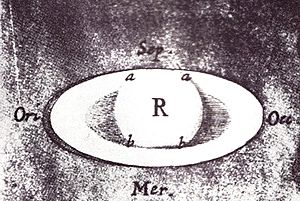
One of the challenging problems Hooke tried to solve was measuring the distance to a star other than the Sun. He chose the star Gamma Draconis and planned to use a method called parallax (measuring how a star's position seems to shift as the Earth moves). After several months of observations in 1669, Hooke thought he had succeeded. However, we now know that his equipment wasn't precise enough for such a difficult measurement.
Hooke's work in astronomy went beyond measuring star distances. His Micrographia book has drawings of the Pleiades star cluster and lunar craters on the Moon. He even did experiments to figure out how these craters might have formed. Hooke was also one of the first to observe the rings of Saturn. In 1664, he discovered one of the first double-star systems, Gamma Arietis.
Memory
Hooke also made an early and important contribution to understanding human memory. In a lecture in 1682, he suggested a scientific model of how human memory works. This was very different from the philosophical ideas that came before it. His model talked about how memories are stored, how much we can remember, how repetition helps, how we recall memories, and why we forget. Some of his ideas were surprisingly accurate compared to modern understanding.
This work was largely forgotten for almost 200 years. It had similarities to later work by Richard Semon in the early 1900s, both suggesting that memories are physical and located in the brain. Hooke's model was ahead of its time.
Architecture & London's Rebuilding
Robert Hooke was the Surveyor to the City of London and the main assistant to Christopher Wren, a very famous architect. In this role, Hooke helped Wren rebuild London after the terrible Great Fire in 1666. He also worked on the design of London's Monument to the fire, the Royal Greenwich Observatory, and the Bethlem Royal Hospital (also known as 'Bedlam').
Other buildings Hooke designed include The Royal College of Physicians (1679), Ragley Hall in Warwickshire, and the church of St Mary Magdalene at Willen in Milton Keynes. Hooke also helped with the design of St Paul's Cathedral, especially the dome's construction method. He also participated in the design of the Pepys Library, which held the famous diaries of Samuel Pepys.
Both Hooke and Wren loved astronomy. The Monument to the Great Fire was designed to also be a telescope for observing transits of stars. However, Hooke's measurements showed that the column moved too much in the wind to be used for this purpose. You can still see this in the design of the spiral staircase, which has no central column, and the observation room underground.
After the Great Fire, Hooke suggested redesigning London's streets in a grid pattern with wide roads, similar to what was later done in Paris and many American cities. But this plan was stopped because of arguments over property rights. Property owners were secretly moving their land boundaries. Hooke was often asked to help settle these disputes because he was a skilled surveyor and a fair arbitrator.
Portraits & Legacy
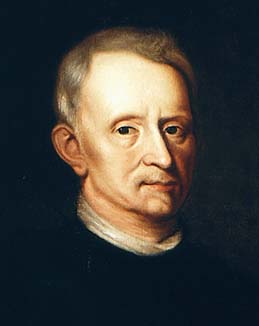
Sadly, there is no confirmed portrait of Robert Hooke that we know for sure is him. Some people have blamed this on the conflicts between Hooke and Newton, suggesting Newton might have destroyed Hooke's portrait. However, some historians say this is a myth.
A visitor to the Royal Society in 1710 mentioned seeing portraits of "Boyle and Hoock" that were good likenesses. Boyle's portrait still exists, but Hooke's is gone. When the Royal Society moved to a new building in 1710, Hooke's portrait went missing and has never been found.
There are two written descriptions of Hooke's appearance from his time. In 2003, a historian thought she found a portrait of Hooke, but it was later shown to be of another scholar, Jan Baptist van Helmont.
Other possible images of Hooke include:
- A seal Hooke used, which has a profile of a man's head.
- An engraving in a 1728 book, showing a drawing of a bust of Hooke.
- A memorial window at St Helen's Church, Bishopsgate in London, which was destroyed in a bombing in 1993.
In 2003, an artist named Rita Greer started a project to create believable images of Hooke based on descriptions from his friends. Her images have been used in TV shows, books, and magazines.
In 2019, a professor named Dr. Larry Griffing suggested that a painting called "Portrait of a Mathematician" by Mary Beale might actually be Hooke. The person in the painting has features that match descriptions of Hooke. The painting also shows a drawing of elliptical motion, which matches an unpublished work by Hooke. Griffing believes the painting might have once belonged to the Royal Society but was left behind when Newton moved the society's headquarters.
Commemorations
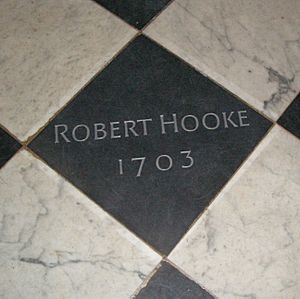
- 3514 Hooke, an asteroid (a small rocky body in space)
- Craters on the Moon and on Mars are named in his honor.
- The Hooke Medal (a science award)
- Robert Hooke Science Centre, Westminster School, London
- The Boyle-Hooke plaque in Oxford
Works
- Reponse de Monsieur Hook aux considerations de M. Auzout... (1665)
- Lectures de potentia restitutiva, or, Of spring explaining the power of springing bodies (1678)
- Attempt to prove the motion of the earth (1679)
- Micrographia (1665)
- Collection of Lectures: Physical, Mechanical, Geographical and Astronomical. (1679)
- Philosophical experiments and observations (1726)
- The posthumous works of Robert Hooke... (1705)
See also
 In Spanish: Robert Hooke para niños
In Spanish: Robert Hooke para niños
- Catenary
- Great Red Spot
- Hooke's atom
- Hooke's law
- Optical microscope
- Reticle
- Sash window
- Savart wheel
- Shadowgraph
- Universal joint
- List of astronomical instrument makers


